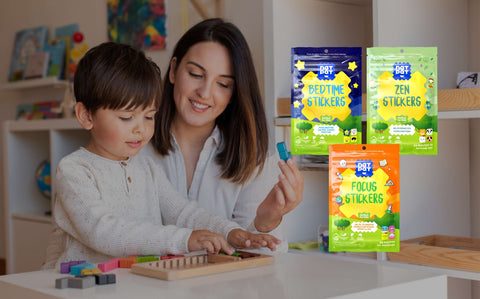At the end of a long day, there’s nothing that we parents want more than to fall into bed and hopefully be undisturbed for as long as possible. As parents, though, we know that a night like this would be a borderline miracle.
That being said, there are ways that we can help our kids fall asleep fast and stay asleep throughout the night so that the whole family can have a better tomorrow.
1. Use the Natural Powers of Essential Oils
There are so many ways that essential oils can help us throughout our lives, and it’s only natural to want those benefits for our kids too. Speaking of natural, let’s discuss a variety of products that help kids and adults by using essential oils.
You can enhance your whole family’s bedtime routine by adding SleepyPatch Sleep Promoting Stickers to the mix. Simply place the patch onto clothing, and those young and old can be quickly soothed into a restful and restorative slumber. With oils such as mandarin, sweet marjoram, vetiver, and lavender, you and your kids will be asleep in no time.
Not only are these delightful patches effective, but they’re also adorable. Featuring patterns of smiling stars and moons, any child would be happy to sport these cute patches on their favorite pair of PJs. You can even match stickers with your child, making them feel even closer to you.
2. Turn Off All Devices Ahead of Time
Many of our kids can’t seem to take their eyes off of the television or away from a beloved iPad, but this actually has the ability to worsen their sleep. Research revolving around sleep medicine and circadian rhythms has determined that blue light messes with our internal clocks, making sleep harder to come by. As a result, it’s best for us to limit screen time throughout the day, but especially before bed.
3. Use an Essential Oil Diffuser
Our SleepyPatches are chock full of beneficial and calming essential oils, but it’s possible that you or your child might want a bit more to set the atmosphere. Setting up an essential oil diffuser before your kid goes to bed can help their sleep environment smell comfortable, encouraging deep breathing.
This deep breathing, along with the effective aromatherapy inspiring feelings of coziness, will have kids and adults getting a good night’s sleep before they know it. You can keep the essential oil diffuser emitting subtle scents throughout the night, or you can use it before bed to set the vibe for the room. Some oil diffusers even allow you to set a sleep timer, so your kids can be lulled off to dreamland without you having to sneak in and turn it off.
In case you’re wondering what kind of essential oils will help to lower the likelihood of your child’s sleep going interrupted, look no further than the ever-popular lavender. Lavender is excellent for relaxation, focus, and feeling centered. There’s a reason that it’s so prominently featured in our SleepyPatches, after all.
Using an oil diffuser in tandem with our patches will help your child get hours and hours of sleep, allowing them to wake up well rested.
4. Keep Their Favorite and Most Comforting Toys Nearby
Think back to the days of your childhood. Chances are that you had at least one stuffed animal or another type of toy that made you feel utterly at home and content. Perhaps it was a classic teddy bear or some kind of doll. No matter what it was, you knew that you could hug that toy tight, and everything would be okay.
There’s no doubt that being a kid nowadays looks significantly different than it did even just a few years ago. That being said, there are certain parts of childhood that will never go away. Having a favorite comfort or safety item is very much one of those parts.
Even in the moments when you can’t be with your child – shockingly, parents do need to sleep, too – they can turn to this toy for comfort. This helps to teach them emotional regulation skills that will be integral as they age and will help them immensely in everyday situations.
That isn’t to say that your child should avoid reaching out to you for help. If they have a nightmare or need something throughout the course of the night, they should feel comfortable and know that they can find you if needed. For smaller issues and concerns about things that go bump in the night, your child can gain confidence and independence with their comforting toy.
5. Set Up a Nightlight
Fear of the dark is incredibly common amongst kids and is likely more common among adults than many of us would like to admit. When you combine the scary nature of the unknown and an overactive imagination, unpleasant results and unsettling images are likely to follow. Unsurprisingly, no group of people has a more overactive imagination than our kids.
You can help your kids feel less afraid of the dark by limiting their exposure to scary stimuli. If they have seen something scary, try talking to them about what they’ve seen and why it is nothing to be afraid of. For instance, if they are afraid of the space under their bed, patiently show them that these places are perfectly safe.
Unfortunately, logic is not always effective in the face of fear, especially when it comes to our kids. To help them feel less scared of what they can’t see, you can illuminate their space. Of course, turning on all the lights is not at all conducive to sleep and will inevitably get in the way of your child’s natural circadian rhythm. Instead, help your kid get better sleep by plugging in a night light.
6. Consider a White Noise Machine
When attempting to fall asleep, we need all of our senses to be in sync. We’ve already covered the importance of smell in making us feel content, and even though our eyes are closed, sight is incredibly important as well. Unfortunately, focusing on these two senses can occasionally cause us to forget about another important factor: sound.
Some people might need complete silence to fall asleep, but that isn’t the case for everybody. In actuality, one of the most popular hacks to help a child fall asleep revolves around making noise.
After dimming lights, setting the diffuser, and finishing up their bedtime story, you might think that the bedtime routine is done. However, some kids might be able to maintain a healthier sleep schedule with the help of a white noise machine.
Many babies rest easier with the help of some white noise in the background, making this tool very important when sleep training infants. Just make sure to set the sound to a fairly low level. This ensures that your child will not be compromised by noises that are too loud for their young ears. You can also set the machine to turn off shortly after your child finally falls asleep.
7. Establish a Consistent Bedtime Routine
Consistency is key for kids in almost every facet of their lives. From the moment they wake up to the moment they go to bed, children crave a sense of structure. For this article, we’re focussing more on the end of the day rather than the beginning of it, but they can both factor into each other.
If a child had trouble sleeping the night before, chances are that getting them up and ready for the next day will be significantly harder. This is the last thing that any parent wants, so maintaining proper sleep hygiene by establishing healthy sleep habits is crucial.
When we create a bedtime routine for our kids and stick to it, we signal to them that it’s time for rest. By going through these familiar motions, our kids know what to expect and will have a much easier time going to sleep fast. Routines help kids feel more confident and secure, leading to an overall increase in their mental health.
Many kids’ nightly routines include rituals like brushing their teeth, reading bedtime stories, taking a warm bath, and more. Finding the exact proper routine for you and your child might take a bit of trial and error but will often center around what a child needs, including physical and emotional care.
8. Keep Their Stress Levels to a Minimum
We’ve all had those nights when our minds are racing, and we can’t seem to get a moment’s reprieve, let alone quality rest. We might be worried about a big project coming up at work or dealing with pesky in-laws. Having too much on our minds is a contributing factor to how quickly we’re able to fall asleep. This is true for our kids, too.
Although the worries of a preschooler will hopefully look very different from adults’ concerns, they are still completely legitimate. Being stressed out during the day can play a significant role in your kid's sleep problems. Stress can have a whole host of other disadvantages in terms of a child’s health as well. For all of these reasons, it’s in everyone’s best interest to reduce stress levels as much as possible whenever you can.
If your child is worried about an important test coming up, try to do a little bit of studying every day so that they’ll feel prepared when it finally happens. Cramming too much studying in too close to the day of the test can make the situation even tenser. By studying incrementally with your child, you’re also helping them establish healthy habits that will serve them well throughout their academic career.
If there’s some kind of disruption at home, try your best to keep your kid’s routine as consistent as possible. This might be difficult sometimes, especially if a significant life event like a move occurs. Take stock of what you can control, and do what you can to help your child feel comforted.
There are times in life when stress is inevitable, but we owe it to our kids to try to minimize stress’ effects when we can.
How Do You Sleep at Night?
Our ability to sleep soundly at night has a surprising amount to do with the routines we were taught as children. By helping our kids feel supported emotionally, physically, and spiritually, they can set up foundations that will serve them well for years.
Sources:
For Kids, Fear of the Dark Is Common. Here Are Ways To Help Them | Washington Post
White Noise and Sleep Induction | PMC


